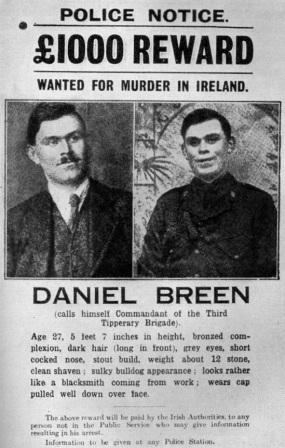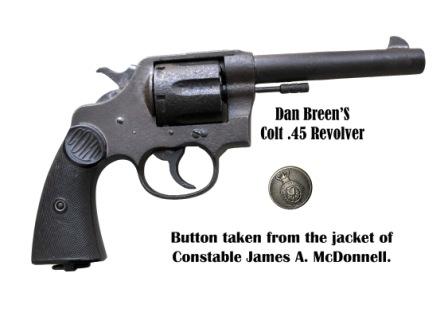 This day the 21st January, 100 years ago, in 1919 Sinn Féin candidates who had been elected in the Westminster elections of 1918 refused to recognise the Parliament of the United Kingdom and instead assembled as a revolutionary parliament called “Dáil Éireann”. This first meeting of Dáil Éireann on 21st January 1919 was held in the Round Room of the Mansion House. Unlike the normal picture which depicts the first Dáil this photo shows the true first assembly. Éamon de Valera and Arthur Griffith were both in jail on January 21st and Michael Collins, much sought by British Forces together with Harry Boland were busy preparing plans for the successful escape of Éamon de Valera from Lincoln Gaol.
This day the 21st January, 100 years ago, in 1919 Sinn Féin candidates who had been elected in the Westminster elections of 1918 refused to recognise the Parliament of the United Kingdom and instead assembled as a revolutionary parliament called “Dáil Éireann”. This first meeting of Dáil Éireann on 21st January 1919 was held in the Round Room of the Mansion House. Unlike the normal picture which depicts the first Dáil this photo shows the true first assembly. Éamon de Valera and Arthur Griffith were both in jail on January 21st and Michael Collins, much sought by British Forces together with Harry Boland were busy preparing plans for the successful escape of Éamon de Valera from Lincoln Gaol.
Prior to 1919, Sinn Féin’s popularity had increased dramatically, following the execution by Englands Major General Sir John Maxwell, of most of some 90 leaders of the 1916 rebellion. Sinn Féin had won 73 out of the 105 Irish seats in the Westminster parliament and the party’s founder, Arthur Griffith, believed that Irish nationalists should emulate the means by which Hungarian nationalists, led by Ferenc Deák, had achieved partial independence from Austria.
However, on precisely the same day as the Dáil’s first meeting took place, two members of the Royal Irish Constabulary were ambushed and killed at Soloheadbeg, in Co. Tipperary, by members of the Irish Volunteers, later to be known as the 3rd. Tipperary Brigade of the IRA. This incident had not been ordered by the Dáil but the course of events soon drove the Dáil to recognise the Volunteers as the army of the Irish Republic and the ambush to be seen as an act of war against Great Britain.
The Tipperary Connection.
In relating this historical blog we will again unveil yet another secret of the true hidden Ireland that is Tipperary.
Soloheadbeg is a small townsland near Limerick Junction railway station. The place is steeped in Irish history, for it was here that King Mahon of Thomond together with his brother Brian Ború defeated the vikings at the Battle of Solohead in 968. It was here also that Dónal Cam O’Sullivan Bere stopped on his epic march from Dunboy Castle in west Cork to O’Rourke’s Castle in Leitrim in 1603.
 On 21st January 1919, two Irish born catholic RIC constables, James Alec McDonnell and Patrick O’Connell, were escorting a horse drawn cart containing a load of gelignite taken from the Tipperary town Military Barracks. This gelignite, was destined for use for blasting purposes, at the local Soloheadbeg Quarry. The driver of the cart was James Godfrey, accompanied by Patrick Flynn, the latter a County Council employee.
On 21st January 1919, two Irish born catholic RIC constables, James Alec McDonnell and Patrick O’Connell, were escorting a horse drawn cart containing a load of gelignite taken from the Tipperary town Military Barracks. This gelignite, was destined for use for blasting purposes, at the local Soloheadbeg Quarry. The driver of the cart was James Godfrey, accompanied by Patrick Flynn, the latter a County Council employee.
Constable McDonnell, was a native of Belmullet, Co. Mayo and a widower with seven children. His comrade Constable O’Connell, was a native of Coachford, County Cork, and unmarried. Both men, according to local reports, were reasonably popular as policemen in the area.
Possibly up to eight armed and masked men, members of the then Irish Volunteers from the South Tipperary Brigade, which included their leader Séamus Robbinson, OC; Sean  Tracy, Vice OC; Dan Breen, QM; Sean Hogan, Tadgh Crowe, Patrick Dwyer, Michael Ryan, and Patrick McCormack fired on the Constables, killing both men. Volunteer GHQ had not sanctioned this ambush. The driver and County Council worker were left unharmed. In the pocket of Constable McDonnell’s uniform were 30 electric detonators which remained undiscovered by their assailants. Hogan with Treacy and Breen drove the cart, together with the explosives, away from the scene, while the others involved scattered in the opposite direction. Eye witnesses later saw the cart been driven at high speed in the direction of Dundrum village, in Co. Tipperary, and indeed the horse and cart, minus its contents, were later found abandoned at Allen Creamery, near Dundrum, by District Inspector Poer O’Shee of Clonmel.
Tracy, Vice OC; Dan Breen, QM; Sean Hogan, Tadgh Crowe, Patrick Dwyer, Michael Ryan, and Patrick McCormack fired on the Constables, killing both men. Volunteer GHQ had not sanctioned this ambush. The driver and County Council worker were left unharmed. In the pocket of Constable McDonnell’s uniform were 30 electric detonators which remained undiscovered by their assailants. Hogan with Treacy and Breen drove the cart, together with the explosives, away from the scene, while the others involved scattered in the opposite direction. Eye witnesses later saw the cart been driven at high speed in the direction of Dundrum village, in Co. Tipperary, and indeed the horse and cart, minus its contents, were later found abandoned at Allen Creamery, near Dundrum, by District Inspector Poer O’Shee of Clonmel.
Condemnation for the killings was swift and from every quarter, even from some well known local republicans and local priests. Dan Breen claimed the constables attacked first, but a body of opinion says that this was unlikely given the odds against them. Dan Breen claims in his book “My fight for Irish Freedom” that the constables raised their rifles in preparation for a fight and that they were forced to kill the two constables.
However Breen also later recalled:”…we took the action deliberately, having thought over the matter and talked it over between us. Treacy had stated to me that the only way of starting a war was to kill someone, and we wanted to start a war, so we intended to kill some of the police whom we looked upon as the foremost and most important branch of the enemy forces … The only regret that we had following the ambush was that there were only two policemen in it, instead of the six we had expected.
The real facts of this incident are possibly forever lost in history.
The following day Martial Law was imposed in Co.Tipperary. A reward of £1,000 was offered for information, shown on wanted posters displaying photographs of Dan Breen, which were immediately posted outside every police barracks in the country.
The Soloheadbeg incident is still regarded as the first opening act of the Irish War of Independence, though the Dáil did not formally declare war on Britain until 1921.
Sean Treacy was later killed by British forces and was buried at Kilfeacle in October, 1920. Breen went on to serve as a politician and member of Dáil Éireann (anti-Treaty) from 1923-1927 and 1932-1965. He died in Dublin in 1969 and was buried in Donohill.

I am publishing a special edition of the Easter Commemoration for 2016.
I would like to use the photo of the “true” Fist Dail. in an article on the First Dail.
Please advise if you can agree to this.
I am open to receive articles/Photos relative to 1916.
All data will be fully acknowledged.
Hi Sean,
Please feel free to use relative data / photo. Acknowledge “St Mary’s Famine & War Museum, Thurles, Co Tipperary.”
Kindest regards